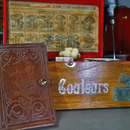Introduction: Victorian Steampunk Inspired Shelf
Having recently moved office to the location of the former premises of the cabinet maker Mr. Chippendale who was quite famous for his legs I was inspired to make,err a shelf. A very tenuous link :)
However I did have an existing shelf of knick-knacks that was not very pleasing and needed something to sort this area of the workshop out. The initial plan was just to screw a bit of wood onto some dowels and be done with it, but one thing led to another and you have what you see here now. A shelf with Victorian looking legs reminiscent of a seaside pier.
Step 1: Wooden Shelf
First step is to take a piece of 6mm plywood and cut it to shape. Along the front and back edges I also glued and nailed some 6mm square dowelling. I've done this so that items placed on the shelf don't fall down the back and get lost forever. I also hesitantly use the size 6mm, when in fact its one of worlds dirtiest secrets that it is really 6.35 , which in turn is 1/4". Even though it has been illegal in this country for years to sell goods in imperial measurements the entire wood industry still knocks everything out sized that way.
After fixing on some edging, it was then coated in some walnut coloured varnish and left to dry.
Step 2: Edges and Trim
I felt that the sides also needed some edging and having run out of the square dowel I just grabbed some paint stirrers. The wood on these is very easy to split so I drilled holes in the end of them and then tacked and glued them to the sides. This would be enough to stop anything slipping off the sides of the shelf into the dark abyss of the workshop floor.
Step 3: Printing the Parts
As all projects run away with design creep, what started as a simple end cap turned into something more elaborate. I've printed these out in ABS and designed to fit some 32mm waste pipe. Don't tell the authorities, but the plumbers are bucking the legal system as well as the chippies 32mm happens to be 1 1/4" internal diameter. So if you actually measured it you'll find its 31.75mm. I've often wondered if chippie, the UK slang for a woodworker comes from chippendale, or the wood chips they make.
The pipe in any case was cut to 21cm because I'm law abiding, although i made 4 of them which is neither imperial or metric.
Step 4: Painting and Gluing the Legs
It was a simple case of pushing on the ends and gluing them with some superglue and then spraying them matt black. One end cap is enclosed and fits tight on the tube, whilst the other is open ended so it is easier to slide up and down and you can then make sure they are all level if you havent cut them all exactly to the same length.
Step 5: Weathering the Supports
With a walnut covered shelf, the blue ABS and white domestic pipe didnt exactly scream Victorian, or pier for that matter. Out came the acrylic paints and after several coats of different types of umber and sienna (mostly burnt umber and burnt sienna as it seems painters are pyromaniacs) I ended up with something akin to old rusty iron.
Step 6: Fixing the Legs
With the legs dried it was just a simple case of measuring and drilling some holes through the shelf and screwing the legs on with some short wood screws.
Step 7: Finished Shelf
The finished article looks pretty authentic and antique looking. The shelf is installed and it now doesn't look like someone has just dumped a load of tat in the workshop.It now looks like someone has dumped a load of old tat on an old shelf instead.

Participated in the
Organization Contest













